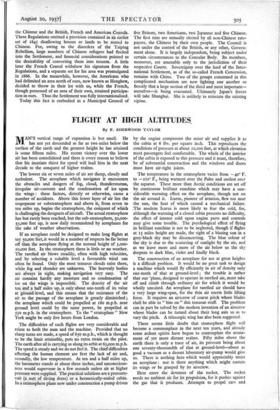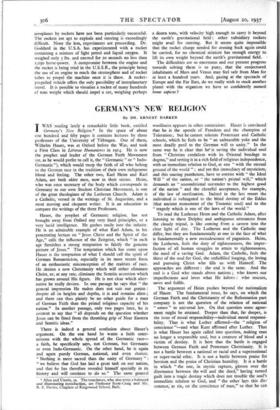FLIGHT AT HIGH ALTITUDES
By F. SHERWOOD TAYLOR
MAN'S vertical range of expansion- is but small. He has not yet descended as far as two miles below the surface of the earth and the greatest height he has attained is some fifteen miles. His recent victory over the lower air has been consolidated and there is every reason to believe that his insatiate thirst for speed will lead him in the next decade to the conquest of higher realms.
The lowest six or seven miles of air are damp, cloudy and turbulent. The aeroplane which navigates it encounters the obstacles and dangers of fog, cloud, thunderstorms, irregular air-currents and the condensation of ice upon the wings : these factors, directly or otherwise, cause a number of accidents. Above this lower layer of air lies the tropopause or substratosphere and above it, from seven to ten miles up, begins the stratosphere, the conquest of which is challenging the designers of aircraft. The actual stratosphere has but rarely been reached, but the sub-stratosphere, 30,000- 35,000 feet up, is now daily reconnoitred by aeroplanes for the sake of weather observations.
If an aeroplane could be designed to make long flights at say 50,000 feet, it would in a number of respects be far better off than the aeroplane flying at the normal height of 5,000- to,000 feet. In the stratosphere there is little or no weather. The rarefied air blows steadily, often with high velocities, and by selecting a suitable level a favourable wind can often be found. Only the most tenuous clouds exist there, while fog and thunder are unknown. The heavenly bodies are always in sight, making navigation very easy. The air contains hardly any moisture and so condensation of ice on the wings is impossible. The density of the air ten and A half miles up, is only about one-tenth of its value at grOund-level, and this means that the resistance of the air to the passage of the aeroplane is greatly diminished ; the aeroplane which could be propelled at 18o m.p.h. near ground level could by the same power, be propelled at 55o m.p.h. in the stratosphere. To the " stratoplane " New York might be only five hours from London.
The difficulties of such flights are very considerable and relate to both the man and the machine. Provided that no sharp turns are made, a speed of 65o m.p.h., which is thought to be the limit attainable, puts no extra strain on the pilot. The earth after all is carrying us along its orbit at 65,000 m.p.h. The speed is steady and we do not feel it. The chief difficulties affecting the human element are first the lack of air and, secondly, the low temperature. At ten and a half miles up, the barometer stands at about three inches, and unconscious- ness would supervene in a few seconds unless air at higher pressure were supplied. The practical solutions are a pressure- suit (a sort of diving dress) or a hermetically-sealed cabin. In a stratosphere plane now under construction a pump driven by the engine compresses the outer air and supplies it to the cabin at 6 lbs. per square inch. This reproduces the conditions of pressure at about to,000 feet, at which elevation most passengers feel comfortable. The whole of the interior of the cabin is exposed to this pressure and it must, therefore, be of substantial construction and the windows and doors must have air-tight joints.
The temperature in the stratosphere varies from —40° F. to — I to° F., being warmest over the Poles and coolest over the equator. These more than Arctic conditions are set off by continuous brilliant sunshine which may have a con- siderable warming effect on the aeroplane, though not on the air around it. Icarus, pioneer of aviation, flew too near the sun, the heat of which caused a mechanical failure. .The modern Icarus is more likely to fear the cold, for, although the warming of a closed cabin presents no difficulty, the effect of intense cold upon engine parts and controls may give some trouble. The psychological effect of flying in brilliant sunshine is not to be neglected, though if flights at 15 miles height are made, the sight of a blazing sun in a grey-black sky may be disconcerting. The blue colour of the sky is due to the scattering of sunlight by the air, and as we leave more and more of the air below us the sky deepens to dark blue, violet and finally black.
The construction of an aeroplane for use at great heights is a difficult problem. It would be no great task to design a machine which would fly efficiently in air of density only one-tenth of that at ground-level ; the trouble is rather that our 'plane, designed to operate in rarefied air, must take off and climb through ordinary air for which it would be wholly unsuited. An aeroplane for rarefied air should have a very large wing-span, for the thin air exerts little lifting force. It requires an airscrew of coarse pitch whose blades shall be able to " bite on " this tenuous stuff. The problem can in part be solved by the modem invention of an airscrew whose blades can be turned about their long axis so as to vary the pitch. A telescopic wing has also been suggested.
There seems little doubt that stratosphere flight will become a commonplace in the next tea years, and already some ardent spirits have begun to contemplate the attain- ment of yet more distant realms. Fifty miles above the earth there is only a trace of air, its pressure being about one seventy-thousandth of that at ground-level—about as good a vacuum as a decent laboratory air-pump would give us. There is nothing here which would appreciably resist an aeroplane : nor is there anything which might sustain its wings or be grasped by its airscrew.
Here enter the devotees of the rocket. The rocket needs no ambient air for its propulsion, for it pushes against the gas that it produces. Attempts to propel cars and aeroplanes by rockets have not been particularly successful. The rockets are apt to explode and steering is exceedingly difficult. None the less, experiments are proceeding. Dr. Goddard in the U.S.A. has experimented with a rocket containing a mixture of light petrol and liquid oxygen. It weighed only 5 lbs. and exerted for zo seconds no less than 1,o3o horse-power. A compromise between the engine and the rocket is being tried in the U.S.S.R., the principle being the use of an engine to reach the stratosphere and of rocket tubes to propel the machine once it is there. A rocket- propelled vehicle offers the only possibility of interplanetary travel. It is possible to visualise a rocket of many hundreds of tons weight which should impel a car, weighing perhaps a dozen tons, with velocity high enough to carry it beyond the earth's gravitational field : other subsidiary rockets might avail for steering. But it seems quite impossible that the rocket charge needed for coming back again could be carried, for no chemical mixture has enough energy to lift its own weight beyond the earth's gravitational field.
The difficulties are so enormous and our present progress towards solving them is so puny, that the conjectured inhabitants of Mars and Venus may feel safe from Man for at least a hundred years. And, gazing at the spectacle of Europe and the Far East, do we really wish to stock another planet with the organism we have so confidently named, homo sapiens?







































 Previous page
Previous page